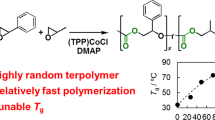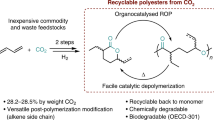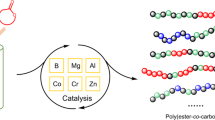Abstract
Although carbon dioxide has attracted broad interest as a renewable carbon feedstock, its use as a monomer in copolymerization with olefins has long been an elusive endeavour. A major obstacle for this process is that the propagation step involving carbon dioxide is endothermic; typically, attempted reactions between carbon dioxide and an olefin preferentially yield olefin homopolymerization. Here we report a strategy to circumvent the thermodynamic and kinetic barriers for copolymerizations of carbon dioxide and olefins by using a metastable lactone intermediate, 3-ethylidene-6-vinyltetrahydro-2H-pyran-2-one, which is formed by the palladium-catalysed condensation of carbon dioxide and 1,3-butadiene. Subsequent free-radical polymerization of the lactone intermediate afforded polymers of high molecular weight with a carbon dioxide content of 33 mol% (29 wt%). Furthermore, the protocol was applied successfully to a one-pot copolymerization of carbon dioxide and 1,3-butadiene, and one-pot terpolymerizations of carbon dioxide, butadiene and another 1,3-diene. This copolymerization technique provides access to a new class of polymeric materials made from carbon dioxide.
This is a preview of subscription content, access via your institution
Access options
Subscribe to this journal
Receive 12 print issues and online access
$259.00 per year
only $21.58 per issue
Buy this article
- Purchase on Springer Link
- Instant access to full article PDF
Prices may be subject to local taxes which are calculated during checkout




Similar content being viewed by others
References
Aresta, M. Carbon Dioxide as Chemical Feedstock (Wiley-VCH, 2010).
Sakakura, T., Choi, J. C. & Yasuda, H. Transformation of carbon dioxide. Chem. Rev. 107, 2365–2387 (2007).
Arakawa, H. et al. Catalysis research of relevance to carbon management: progress, challenges, and opportunities. Chem. Rev. 101, 953–996 (2001).
Behr, A. Use of carbon dioxide in industrial organic syntheses. Chem. Eng. Technol. 10, 16–27 (1987).
Omae, I. Recent developments in carbon dioxide utilization for the production of organic chemicals. Coord. Chem. Rev. 256, 1384–1405 (2012).
Sumida, K. et al. Carbon dioxide capture in metal–organic frameworks. Chem. Rev. 112, 724–781 (2012).
Huang, K., Sun, C-L. & Shi, Z-J. Transition-metal-catalyzed C–C bond formation through the fixation of carbon dioxide. Chem. Soc. Rev. 40, 2435–2452 (2011).
Tsuji, Y. & Fujihara, T. Carbon dioxide as a carbon source in organic transformation: carbon–carbon bond forming reactions by transition-metal catalysts. Chem. Commun. 48, 9956–9964 (2012).
Aresta, M., Dibenedetto, A. & Angelini, A. The use of solar energy can enhance the conversion of carbon dioxide into energy-rich products: stepping towards artificial photosynthesis. Phil. Trans. R. Soc. A 371, 2012 0111 (2012).
Shaikh, A-A. G. & Sivaram, S. Organic carbonates. Chem. Rev. 96, 951–976 (1996).
Darensbourg, D. J. & Holtcamp, M. W. Catalysts for the reactions of epoxides and carbon dioxide. Coord. Chem. Rev. 153, 155–174 (1996).
Lu, X-B. & Darensbourg, D. J. Cobalt catalysts for the coupling of CO2 and epoxides to provide polycarbonates and cyclic carbonates. Chem. Soc. Rev. 41, 1462–1484 (2012).
Fukuoka, S. et al. A novel non-phosgene polycarbonate production process using by-product CO2 as starting material. Green Chem. 5, 497–507 (2003).
Coates, G. W. & Moore, D. R. Discrete metal-based catalysts for the copolymerization of CO2 and epoxides: discovery, reactivity, optimization, and mechanism. Angew. Chem. Int. Ed. 43, 6618–6639 (2004).
Darensbroug, D. J. Making plastics from carbon dioxide: salen metal complexes as catalysts for the production of polycarbonates from epoxides and CO2 . Chem. Rev. 107, 2388–2410 (2007).
Sugimoto, H. & Inoue, S. Copolymerization of carbon dioxide and epoxide. J. Polym. Sci. A 42, 5561–5573 (2004).
Kember, M. R., Buchard, A. & Williams, C. K. Catalysts for CO2/epoxide copolymerisation. Chem. Commun. 47, 141–163 (2011).
Lejkowski, M. L. et al. The first catalytic synthesis of an acrylate from CO2 and an alkene—a rational approach. Chem. Eur. J. 18, 14017–14025 (2012).
Takaya, J., Sasano, K. & Iwasawa, N. Efficient one-to-one coupling of easily available 1,3-dienes with carbon dioxide. Org. Lett. 13, 1698–1701 (2011).
Williams, C. M., Johnson, J. B. & Rovis, T. Nickel-catalyzed reductive carboxylation of styrenes using CO2 . J. Am. Chem. Soc. 130, 14936–14937 (2008).
Takimoto, M., Nakamura, Y., Kimura, K. & Mori, M. Highly enantioselective catalytic carbon dioxide incorporation reaction: nickel-catalyzed asymmetric carboxylative cyclization of bis-1,3-dienes. J. Am. Chem. Soc. 126, 5956–5957 (2004).
Soga, K., Hosoda, S. & Ikeda, S. Copolymerization of carbon dioxide and some diene compounds. Die Makromol. Chemie 176, 1907–1911 (1975).
Soga, K., Hosoda, S., Tasuka, Y. & Ikeda, S. Copolymerization of carbon dioxide and ethyl vinyl ether. J. Polym. Sci. Polym. Lett. 13, 265–268 (1975).
Soga, K., Sato, M., Hosoda, S. & Ikeda, S. Copolymerization of methyl vinyl ether and carbon dioxide. J. Polym. Sci. Polym. Lett. 13, 543–548 (1975).
Chiang, W-Y. Copolymerization of carbon dioxide and acrylonitrile. Proc. Natl Sci. Council Republic of China 2, 170–176 (1978).
Price, C. J., Reich, B. J. E. & Miller, S. A. Thermodynamic and kinetic considerations in the copolymerization of ethylene and carbon dioxide. Macromolecules 39, 2751–2756 (2006).
Darensbourg, D. J. & Yeung, A. D. Thermodynamics of the carbon dioxide–epoxide copolymerization and kinetics of the metal-free degradation: a computational study. Macromolecules 46, 83–95 (2013).
Sasaki, Y., Inoue, Y. & Hashimoto, H. Reaction of carbon dioxide with butadiene catalysed by palladium complexes. Synthesis of 2-ethylidenehept-5-en-4-olide. J. Chem. Soc. Chem. Commun. 605–606 (1976).
Behr, A. & Henze, G. Use of carbon dioxide in chemical syntheses via a lactone intermediate. Green Chem. 13, 25–39 (2011).
Musco, A. Co-oligomerization of butadiene and carbon dioxide catalysed by tertiary phosphine–palladium complexes. J. Chem. Soc. Perkin Trans. 1 693–698 (1980).
Behr, A. & Juszak, K-D. Palladium-catalyzed reaction of butadiene and carbon dioxide. J. Organomet. Chem. 255, 263–268 (1983).
Behr, A., He, R., Juszak, K-D., Krüger, C. & Tsay, Y-H. Steuerungsmöglichkeiten bei der übergangsmetall-katalysierten umsetzung von 1,3-dienen mit kohlendioxid. Chem. Ber. 119, 991–1015 (1986).
Braunstein, P., Matt, D. & Nobel, D. Carbon dioxide activation and catalytic lactone synthesis by telomerization of butadiene and carbon dioxide. J. Am. Chem. Soc. 110, 3207–3212 (1988).
Dinjus, E. & Leitner, W. New insights into the palladium-catalysed synthesis of δ-lactones from 1,3-dienes and carbon dioxide. Appl. Organomet. Chem. 9, 43–50 (1995).
Pitter, S. & Dinjus, E. Phosphinoalkyl nitriles as hemilabile ligands: new aspects in the homogeneous catalytic coupling of CO2 and 1,3-butadiene. J. Mol. Catal. A 125, 39–45 (1997).
Behr, A. & Heite, M. Telomerisation von kohlendioxid und 1,3-butadien: verfahrensentwicklung via miniplant-technik. Chem. Ing. Tech. 72, 58–61 (2000).
Behr, A. & Becker, M. The telomerisation of 1,3-butadiene and carbon dioxide: process development and optimisation in a continuous miniplant. Dalton Trans. 4607–4613 (2006).
Behr, A., Bahke, P. & Becker, M. Palladium-katalysierte telomerisation von kohlendioxid mit butadien im labor- und miniplantmaßstab. Chem. Ing. Tech. 76, 1828–1832 (2004).
Behr, A., Bahke, P., Klinger, B. & Becker, M. Application of carbonate solvents in the telomerisation of butadiene with carbon dioxide. J. Mol. Catal. A 267, 149–156 (2007).
Haack, V., Dinjus, E. & Pitter, S. Synthesis of polymers with an intact lactone ring structure in the main chain. Die Angew. Makromol. Chem. 257, 19–22 (1998).
Laible, R. C. Allyl polymerizations. Chem. Rev. 58, 807–843 (1958).
Miller, M. L. & Skogman, J. Polymerization of tert-butyl crotonate. J. Polym. Sci. A 2, 4551–4558 (1964).
Kassi, E. & Patrickios, C. S. Well-defined polymers from biosourced monomers: the case of 2-(methacryloyloxy)ethyl tiglate. Macromolecules 43, 1411–1415 (2010).
Kitayama, T. et al. Synthesis and polymerization of methyl 3-methylcyclobutene-1-carboxylate. Macromolecules 35, 1591–1598 (2002).
Chen, X-P., Sufi, B. A., Padias, A. B. & Hall, H. K. Jr. Controlled/‘living’ reverse atom transfer radical polymerization of a monocyclic olefin, methyl 1-cyclobutenecarboxylate. Macromolecules 35, 4277–4281 (2002).
Brandrup, J., Immergut, E. H. & Grulke, E. A. Polymer Handbook 4th edn (Wiley, 1999).
Iio, K., Kobayashi, K. & Matsuo, M. Radical polymerization of allyl alcohol and allyl acetate. Polym. Adv. Technol. 18, 953–958 (2007).
Matyjaszewski, K., Nakagawa, Y. & Jasieczek, C. B. Polymerization of n-butyl acrylate by atom transfer radical polymerization: remarkable effect of ethylene carbonate and other solvents. Macromolecules 31, 1535–1541 (1998).
Sato, T., Shimooka, S., Seno, M. & Tanaka, H. Radical polymerization of ortho-formylphenyl crotonate involving intramolecular hydrogen-abstraction. Eur. Polym. J. 28, 1357–1364 (1992).
Grub, J. & Löser, E. Butadiene. Ullmann's Encyclopedia of Industrial Chemistry (Wiley-VCH, 2011).
Acknowledgements
This work was supported by the Funding Program for Next Generation World-Leading Researchers, Green Innovation and the Global COE Program ‘Chemistry Innovation through Cooperation of Science and Engineering’ from the Ministry of Education, Culture, Sports, Science and Technology (MEXT)/Japan Society for the Promotion of Science, Japan, and a Grant-in-Aid for Innovative Areas ‘Molecular Activation Directed toward Straightforward Synthesis’ from MEXT, Japan. The theoretical calculations were performed using computational resources provided by the Research Center for Computational Science, National Institutes of Natural Sciences, Okazaki, Japan. We are grateful to H. Sugimoto, H. Goto and S. Honda (Tokyo University of Science) for right-angle laser-light scattering (RALLS) analyses for the molecular weights of polymers, and to B. P. Carrow (Princeton University) for careful proofreading.
Author information
Authors and Affiliations
Contributions
All authors designed the studies, discussed the results and wrote the paper. R.N. performed all the experimental and computational work.
Corresponding author
Ethics declarations
Competing interests
The authors declare no competing financial interests.
Supplementary information
Supplementary information
Supplementary information (PDF 5271 kb)
Rights and permissions
About this article
Cite this article
Nakano, R., Ito, S. & Nozaki, K. Copolymerization of carbon dioxide and butadiene via a lactone intermediate. Nature Chem 6, 325–331 (2014). https://doi.org/10.1038/nchem.1882
Received:
Accepted:
Published:
Issue Date:
DOI: https://doi.org/10.1038/nchem.1882
This article is cited by
-
Tunable and recyclable polyesters from CO2 and butadiene
Nature Chemistry (2022)
-
HCAII-inspired catalysts for making carbon dioxide-based copolymers: The role of metal-hydroxide bond
Chinese Journal of Polymer Science (2018)
-
Computational study on the mechanism of the reaction of carbon dioxide with siloxy silanes
Theoretical Chemistry Accounts (2017)
-
Perturbations and 3R in carbon management
Environmental Science and Pollution Research (2017)
-
Using carbon dioxide as a building block in organic synthesis
Nature Communications (2015)



